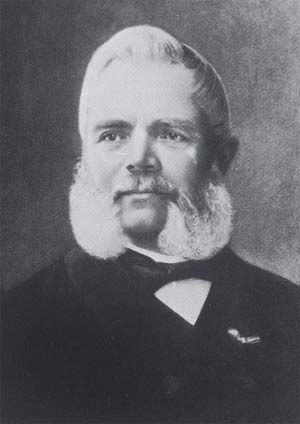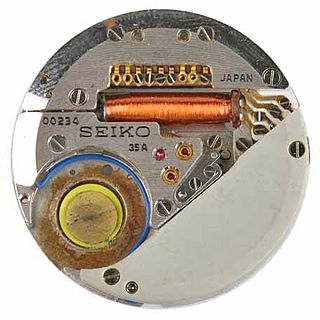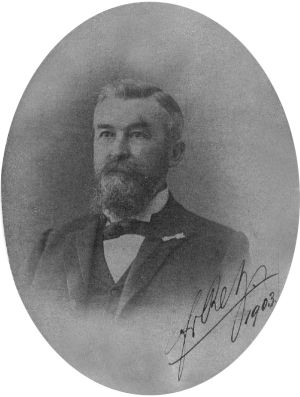
A watch is a timepiece carried or worn by a person. It is designed to keep a consistent movement despite the motions caused by the person's activities. A wristwatch is designed to be worn around the wrist, attached by a watch strap or other type of bracelet, including metal bands or leather straps. A pocket watch is carried in a pocket, often attached to a chain. A stopwatch is a watch that measures intervals of time.
The foreign employees in Meiji Japan, known in Japanese as O-yatoi Gaikokujin, were hired by the Japanese government and municipalities for their specialized knowledge and skill to assist in the modernization of the Meiji period. The term came from Yatoi, was politely applied for hired foreigner as O-yatoi gaikokujin.

Seiko Group Corporation, commonly known as Seiko, is a Japanese maker of watches, clocks, electronic devices, semiconductors, jewelry, and optical products. Founded in 1881 by Kintarō Hattori in Tokyo, Seiko introduced the world's first commercial quartz wristwatch in 1969.
Ulysse NardinSA is a Swiss luxury watchmaking company founded in 1846 in Le Locle, Switzerland.

Breguet is a Swiss luxury watch, clock and jewelry manufacturer founded by Abraham-Louis Breguet in Paris in 1775. Headquartered in L'Abbaye, Switzerland, Breguet is one of the oldest surviving watchmaking brands and a pioneer of numerous watchmaking technologies such as the tourbillon, which was developed into a practical solution by Abraham Breguet in 1801. Abraham Breguet also invented and produced the world's first self-winding watch in 1780, as well as the world's first wristwatch in 1810.

Compagnie des Montres Longines, Francillon S.A., or simply Longines, is a Swiss luxury watchmaker based in Saint-Imier, Switzerland. Founded by Auguste Agassiz in 1832, the company has been a subsidiary of the Swiss Swatch Group and its predecessors since 1983. Its winged hourglass logo, registered in 1889, is the oldest unchanged active trademark registered with WIPO.

Viscount Aoki Shūzō was a Japanese politician and diplomat who served as foreign minister during the Meiji era.

Audemars Piguet Holding SA is a Swiss manufacturer of luxury watches, headquartered in Le Brassus, Switzerland. The company was founded by Jules Louis Audemars and Edward Auguste Piguet in the Vallée de Joux in 1875, acquiring the name Audemars Piguet & Cie in 1881. The company has been family-owned since its founding.

Antoni Norbert Patek was a Polish pioneer in watchmaking and the creator of Swiss watchmaker company Patek Philippe & Co., as well as a Polish independence fighter and political activist.
The "Watch Valley" covers all the Swiss Jura Arc, from Geneva to Basel, and is the primary location of the Swiss watch-making industry.

The quartz crisis (Swiss) or quartz revolution was the advancement in the watchmaking industry caused by the advent of quartz watches in the 1970s and early 1980s, that largely replaced mechanical watches around the world. It caused a significant decline of the Swiss watchmaking industry, which chose to remain focused on traditional mechanical watches, while the majority of the world's watch production shifted to Japanese companies such as Seiko, Citizen and Casio which embraced the new electronic technology. The strategy employed by Swiss makers was to call this revolution a 'crisis' thereby downgrading the advancement from Japanese brands.

Bovet Fleurier SA is a Swiss brand of luxury watchmakers chartered 1 May 1822 in London, UK by Édouard Bovet. It is most noted for its pocket watches manufactured for the Chinese market in the 19th century. Today it produces high-end artistic watches with a style that references its history.
An observatory chronometer is a timepiece that has passed stringent testing and a slate of accuracy tests. Thus, the "observatory trial" developed as the standard process for determining accuracy of timepiece movements. If the chronometer passed the stringent testing, it would be certified.

Favre-Leuba is a Swiss luxury wristwatch manufacturer headquartered in Grenchen, Switzerland, and formerly a pioneer in watch design, manufacturing and distribution. The brand was established in 1737, following the registration of Abraham Favre as a watchmaker. However, the Favre-Leuba family was forced to sell the company's name in 1985 due to the ongoing quartz crisis, which made manufacturing watches more difficult.

François Perregaux was a Swiss watchmaker and businessman. He was the first European watchmaker to travel to Asia (1863) and is remembered for his contribution to establishing the watchmaking industry in Japan.

ZANUTI INC. is a mechanical watch manufacturer established in 1887 by Albert Favre Zanuti, currently headquartered in Switzerland and with regional offices in the United States and Japan.

Kintarō Hattori was a Japanese businessman and one of the first and most important Japanese watchmakers in history, as well as the founder of Seiko, one of the world's largest manufacturers of watches. He was a permanent council member of the Japanese Red Cross.

Friedrich Wilhelm Retz was a German entrepreneur and watchmaker in the early days of Meiji Era in Japan and honorary consul for Holland, Norway and Sweden.















